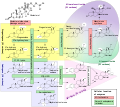Cholesterol side-chain cleavage enzyme
Cholesterol side-chain cleavage enzyme, also known as P450scc or CYP11A1, is a crucial enzyme in the biosynthesis of steroids. It catalyzes the conversion of cholesterol into pregnenolone, a process that marks the first step in the synthesis of all steroid hormones. This enzyme is found in the mitochondria of steroid-producing cells, particularly in the adrenal cortex, gonads, and the placenta. The activity of P450scc is essential for the production of glucocorticoids, mineralocorticoids, androgens, estrogens, and progestogens, which play vital roles in regulating metabolism, immune response, water balance, sexual development, and reproduction.
Function[edit]
The primary function of the cholesterol side-chain cleavage enzyme is to initiate the process of steroidogenesis by converting cholesterol into pregnenolone. This conversion involves the cleavage of a 6-carbon side chain from cholesterol. The enzyme utilizes electron transfer from NADPH via the adrenodoxin reductase and adrenodoxin system, which are also located in the mitochondria. This reaction is the rate-limiting step in the production of steroid hormones.
Structure[edit]
P450scc is a member of the cytochrome P450 superfamily of enzymes, which are characterized by their heme-binding domain. The enzyme's structure allows it to bind to cholesterol and facilitate its conversion into pregnenolone through a series of electron transfers and molecular rearrangements.
Clinical Significance[edit]
Mutations in the CYP11A1 gene, which encodes the P450scc enzyme, can lead to deficiencies in steroid hormone production. Such deficiencies may result in a variety of disorders, including Congenital Adrenal Hyperplasia (CAH), which is characterized by impaired production of cortisol and often an overproduction of androgenic steroids. Diagnosis of P450scc deficiency involves measuring the levels of steroid precursors and hormones in the blood and urine, along with genetic testing for mutations in the CYP11A1 gene.
Treatment[edit]
Treatment for conditions arising from P450scc deficiency typically involves hormone replacement therapy to correct the imbalance of steroid hormones. The specific treatment regimen depends on the hormones that are deficient.
Research Directions[edit]
Research on P450scc continues to explore its role in steroidogenesis and its implications for diseases related to steroid hormone imbalance. Studies are also investigating the potential for targeting this enzyme in the treatment of steroid hormone-dependent cancers.
-
Diagram of steroidogenesis pathways
-
Structure of Dehydroepiandrosterone (DHEA)
-
Structure of Cholesterol
-
Structure of Pregnenolone
Ad. Transform your life with W8MD's Budget GLP-1 injections from $75


W8MD offers a medical weight loss program to lose weight in Philadelphia. Our physician-supervised medical weight loss provides:
- Weight loss injections in NYC (generic and brand names):
- Zepbound / Mounjaro, Wegovy / Ozempic, Saxenda
- Most insurances accepted or discounted self-pay rates. We will obtain insurance prior authorizations if needed.
- Generic GLP1 weight loss injections from $75 for the starting dose.
- Also offer prescription weight loss medications including Phentermine, Qsymia, Diethylpropion, Contrave etc.
NYC weight loss doctor appointmentsNYC weight loss doctor appointments
Start your NYC weight loss journey today at our NYC medical weight loss and Philadelphia medical weight loss clinics.
- Call 718-946-5500 to lose weight in NYC or for medical weight loss in Philadelphia 215-676-2334.
- Tags:NYC medical weight loss, Philadelphia lose weight Zepbound NYC, Budget GLP1 weight loss injections, Wegovy Philadelphia, Wegovy NYC, Philadelphia medical weight loss, Brookly weight loss and Wegovy NYC
|
WikiMD's Wellness Encyclopedia |
| Let Food Be Thy Medicine Medicine Thy Food - Hippocrates |
Medical Disclaimer: WikiMD is not a substitute for professional medical advice. The information on WikiMD is provided as an information resource only, may be incorrect, outdated or misleading, and is not to be used or relied on for any diagnostic or treatment purposes. Please consult your health care provider before making any healthcare decisions or for guidance about a specific medical condition. WikiMD expressly disclaims responsibility, and shall have no liability, for any damages, loss, injury, or liability whatsoever suffered as a result of your reliance on the information contained in this site. By visiting this site you agree to the foregoing terms and conditions, which may from time to time be changed or supplemented by WikiMD. If you do not agree to the foregoing terms and conditions, you should not enter or use this site. See full disclaimer.
Credits:Most images are courtesy of Wikimedia commons, and templates, categories Wikipedia, licensed under CC BY SA or similar.
Translate this page: - East Asian
中文,
日本,
한국어,
South Asian
हिन्दी,
தமிழ்,
తెలుగు,
Urdu,
ಕನ್ನಡ,
Southeast Asian
Indonesian,
Vietnamese,
Thai,
မြန်မာဘာသာ,
বাংলা
European
español,
Deutsch,
français,
Greek,
português do Brasil,
polski,
română,
русский,
Nederlands,
norsk,
svenska,
suomi,
Italian
Middle Eastern & African
عربى,
Turkish,
Persian,
Hebrew,
Afrikaans,
isiZulu,
Kiswahili,
Other
Bulgarian,
Hungarian,
Czech,
Swedish,
മലയാളം,
मराठी,
ਪੰਜਾਬੀ,
ગુજરાતી,
Portuguese,
Ukrainian



